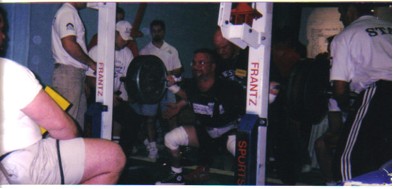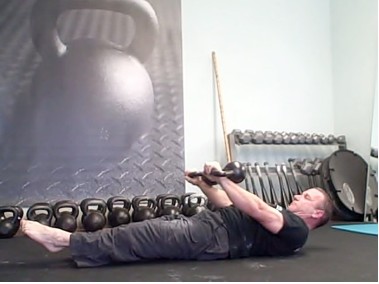Feed Forward Tension
Mark Reifkind, Master RKC
May 12, 2010 11:37 AM

Imagine you standing upright with an empty barbell in your hands. Every few seconds your "friends' add a plate to each side. It doesn't matter if the plates are 45 lbs or 10 lbs, very quickly you will notice something happening; your body is getting tighter. YOUR ENTIRE BODY... If this goes on for very long, or if the weights added get close to your maximum ability every single muscle in your body will be loaded up trying to help to support the weight.
This is Feedback tension. What is happening is that your body is receiving signals that more and more loading is occurring and contracts your muscles to prepare for the increasing load.
But what if you don't know how heavy the load is? What if there is a barbell or a suitcase, or any object on the floor, that you think is heavy and you need to pick up, how would you approach that?
Imagine there is a suitcase that I tell you is loaded with 200 lbs but is actually empty, and I ask you to pick it up. What will happen? Most probably you will be thrown on your butt very quickly as you prepare and then lift the case. Why?
The key word is "PREPARE'. How you "prepared' was to voluntarily and consciously contract your entire musculature in preparation for what you thought was a heavy load. This is feed forward tension, one of the big secrets to successful powerlifters, gymnasts and arm wrestlers, as well as strong people everywhere.
The ability to get tight, and stay tight BEFORE you load the body makes heavy weights feel light and light weights feel like nothing.
Ernie Frantz, one of the Godfathers of modern powerlifting says it like this:
"If the body is tight it can accept any shock". For Ernie, who regularly put 600, 700, 800 lbs and more on his squat and deadlift bars getting tight and staying tight was not an option, it was a necessity, just as it is for all of us who want to get stronger and stay safe.
Imagine again that suitcase, but THIS time I tell you it's empty but it's really loaded to 200 lbs. What will happen now when you pick it up? Well, hopefully you won't hurt your back TOO badly but that's probably what will happen. Why?
Because you thought the load was light enough and it didn't warrant getting tight. This happens to powerlifters ALL the time. Rarely does one get injured with the heaviest weights or maximal attempts. Usually it is during the warmups when one is not respecting the weights, not concentrating very well and "saving' their energy for the "real weights;
Again, from Ernie, "treat your light weight like they are heavy and your heavy weights like they are light". Which means to me: treat them ALL like they are heavy.
Watch Ed Coan, the greatest powerlifter of all time, imho, squat with 135 lbs( his best is over 1000lb). He treats it from the unracking of the weight, to the walkout, to the descent and ascent, just as if it were 1000 lbs. From the mechanics of the movement to the tension levels in his body: the light weight is a chance to PRACTICE for the heavy weight.
One of the most common complaints I hear from students when training for strength skills such as heavy kb pressing or tactical pull-ups, is that when they try to concentrate on keeping one part of the body "tight" something else gets "loose". This is because strength (which is synonymous with tension) is a SKILL and it ain't easy to get and keep everything tight - especially for the 3-8 seconds required to produce maximum force and hence a maximum effort (read PR).
When you tense your glutes your lats get soft. When you get the lats tight the glutes release. Not to mention being able to brace your abs and midsection AND focus on the skill of the lift you are attempting to do! This is easy enough to understand as well as practice in the very simple plank.
Get on the floor with your elbows underneath you and your legs together for those not familiar with the plank position (think of a pushup position on your elbows).
Now, tense the glutes, pull the elbows towards the hips and contract your lats, fire off your core as if bracing for a punch, keep your chin tucked and your neck tight, squeeze the inner thighs and lock them in as well. Now, hold it.
Hold it longer.
Hold it longer.
Easy eh? And this is just bodyweight. This is how tight you need to get BEFORE you get under the squat rack. BEFORE you pull on that deadlift bar. BEFORE you press your KB overhead. Anything that gets loose costs you pounds, maybe the attempt and maybe your lower back or joint health.
Deadlift icon Lamar Gant used to go down to the deadlift bar so slowly it looked like he was squatting a maximal weight. He wanted as much tension as possible in his body before he pulled 666 lbs at a whopping 132 lbs bodyweight.
If you can't hold that tension on a simple plank how can you do it under a maximum attempt lift. The answer: YOU CAN'T. Time to PRACTICE.
This is
feed forward tension, the real domain of the gymnast. What makes gymnasts look like they are moving so effortlessly is the fact that they can get tight and stay tight as long as they need to. Static, or isometric strength is THE strongest contractile ability our bodies possess. We can lower more weight than we can lift but we can HOLD more weight than we can lower or lift.
When you see "form" breaks on a gymnast, what you are seeing is the lack of the athlete in keeping their body tight. In order to do these incredibly complicated movements (or even simple ones like handstands) the body has to be made into as few "segments" as necessary to complete the task. When one is flipping through the air the few "pieces" the body is broken into, the easier it is more move around. Think of a shovel that has a bend in the middle of it. Not much use as a lever is it? Same for a gymnast who gets soft in the core, or the glutes, or anywhere.
Here is a simple drill we use at the RKC to teach feed forward tension in the most direct manner possible. It requires two people. One is on their back with their body rigid. Their partner lifts their legs up until the person on the ground is just up on their shoulders, their body in complete extension from foot to shoulder. Then the partner holding the legs lets go of one of the legs without warning while the person on the ground "tries' to keep the legs from coming apart. Try this and you will immediately understand what staying tight is all about in a very safe manner. Repeat the leg drop drill 3-4 times with each leg then switch partners. You can let go of the legs slowly, it doesn't make it that much easier and dropping the leg too suddenly can upset balance. That's not what we are training here.
Remember to breathe shallow the entire time. It's not safe to hold your breath too long under isometric load. "Breathe behind the shield" as Chief Instructor Pavel says. This means keep breathing but don't get loose. You'll figure it out quickly. Or not.
Now, try this the other way. Get into a pushup position with the partner holding your feet. Get locked in and the partner now drops a foot. Don't let the legs come apart. Ok, try again. And again. You learn how to get tight and stay tight.
The next time you see a gymnast on the rings doing ANYTHING, much less an advanced strength skill such as an Iron Cross, a front or back lever (which the floor drill on the back resembles very intimately) you will have a much greater respect for the "unseen" strength of these incredible athletes.
And it can be yours too, if you practice the SKILL of strength even when it is not required: on your lighter weights, on your "practice" skills, before you NEED it. I even like to practice this when I am doing the movement pattern with NO WEIGHT.
Virtual practice: I imagine I am pressing a heavy weight and just ""going through the motions". Practicing getting tight and staying tight, feeling what gives out first, and focusing on not letting it happen when I'm under real load, because by then it's TOO late.
Remember this:
strength is tension and tension is strength.

To improve one, improve the other as the Chief says.
Mastering
feed forward tension is just one more crucial tool in your tool box of strength: one that will get you STRONGER than you ever thought possible and FASTER than you ever thought possible.
Simple, but not easy.
Practice comrades.
Mark Reifkind, Master RKCOwner - Girya Kettlebell Training, Master Russian Kettlebell Instructor.
136 Hamilton Ave.Palo Alto Ca.
Email: info@giryastrength.comBlog: http://www.rifsblog.blogspot.com
Back